Shanghai, China
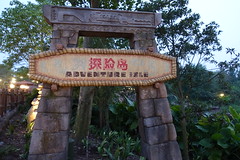 In a lot of ways Adventure Isle feels like it doesn’t quite belong at Shanghai Disneyland. It’s already a bit redundant being half of a shared mega-Adventureland with Treasure Cove. The attractions all originate from second-gate Disney parks, making it feel slightly uncanny that they’d be featured in a main-gate Magic Kingdom style park. The entire land feels geared toward a slightly older demographic than is usual for a castle-style park, with a greater emphasis on myth-making and less on the wacky-exotic visuals that typically define an Adventureland. But perhaps what makes it most out of place is the fact that it’s based on an original storyline and is completely free of Disney IP.
In a lot of ways Adventure Isle feels like it doesn’t quite belong at Shanghai Disneyland. It’s already a bit redundant being half of a shared mega-Adventureland with Treasure Cove. The attractions all originate from second-gate Disney parks, making it feel slightly uncanny that they’d be featured in a main-gate Magic Kingdom style park. The entire land feels geared toward a slightly older demographic than is usual for a castle-style park, with a greater emphasis on myth-making and less on the wacky-exotic visuals that typically define an Adventureland. But perhaps what makes it most out of place is the fact that it’s based on an original storyline and is completely free of Disney IP.
 As I mentioned in the first part of this series, Shanghai Disneyland has subtly shifted the thesis of the Magic Kingdom style park from genre to IP, making the entire park a statement on the Disney brand by virtue that every significant attraction we’ve come across so far in our journey (except for the Jet Packs in Tomorrowland) is based on a recognizable Disney IP. Adventure Isle is the one area that stands in defiance to that thesis of “theme park as manifestations of brand”, with its more broadly cultural theme that doesn’t easily apply to anything that’s recognizable to an international audience as “Disney canon”. While I don’t particularly like that thesis nor mind having a pocket of original design within it, it does serve
As I mentioned in the first part of this series, Shanghai Disneyland has subtly shifted the thesis of the Magic Kingdom style park from genre to IP, making the entire park a statement on the Disney brand by virtue that every significant attraction we’ve come across so far in our journey (except for the Jet Packs in Tomorrowland) is based on a recognizable Disney IP. Adventure Isle is the one area that stands in defiance to that thesis of “theme park as manifestations of brand”, with its more broadly cultural theme that doesn’t easily apply to anything that’s recognizable to an international audience as “Disney canon”. While I don’t particularly like that thesis nor mind having a pocket of original design within it, it does serve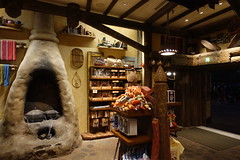 to further muddy a park that’s already slightly off-balance and an odd mix of identities. How does Adventure Isle help further the story of the entirety of Shanghai Disneyland? (Assuming there even is one?)
to further muddy a park that’s already slightly off-balance and an odd mix of identities. How does Adventure Isle help further the story of the entirety of Shanghai Disneyland? (Assuming there even is one?)
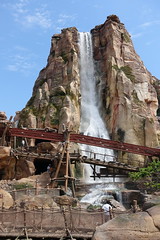 It doesn’t, and there probably isn’t one, but none of that also matters too much, because by unburdening itself of some of the limitations imposed on the other IP centric lands,1 Adventure Isle has freed itself to become probably the best overall immersive environment in the entire
It doesn’t, and there probably isn’t one, but none of that also matters too much, because by unburdening itself of some of the limitations imposed on the other IP centric lands,1 Adventure Isle has freed itself to become probably the best overall immersive environment in the entire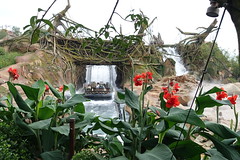 park. Tomorrowland is sleek and cohesive, Mickey Avenue is cute and clever, Treasure Cove has lots of small detail, but fans of immersive themed design should make no doubt that Adventure Isle is where it’s at. It’s basically Adventureland by way of Animal Kingdom, but with the attraction program of California Adventure’s expanded Grizzly Peak and a sprinkle of DisneySea’s Mysterious Island and Lost River Delta thrown in for good measure. What’s not to like?
park. Tomorrowland is sleek and cohesive, Mickey Avenue is cute and clever, Treasure Cove has lots of small detail, but fans of immersive themed design should make no doubt that Adventure Isle is where it’s at. It’s basically Adventureland by way of Animal Kingdom, but with the attraction program of California Adventure’s expanded Grizzly Peak and a sprinkle of DisneySea’s Mysterious Island and Lost River Delta thrown in for good measure. What’s not to like?
Entering from Treasure Cove, the first attraction we come across is Soaring Over the Horizon. You have to look for it, as it’s at the end of an easy-to-miss cul-de-sac branching off the main pathway. (There’s also a Tarzan show back there that I’ve heard is similar to Festival of the Lion King, but I didn’t see it.)
Apart from the signs, this grand rockwork is the only indication that there’s a major E-ticket attraction back here.
While we intended to get FastPasses for it first thing in the morning on our second day, the crowds on Friday compared to Thursday meant that they sold out much more quickly than we expected, and combined with our sleeping in a bit later meant we’d be doing the stand-by line instead.
Fortunately the 75 minutes seemed to incorporate the full ride time itself, and I knew going in that Soaring Over the Horizon would feature one of the park’s better indoor queuing spaces.
First we navigate through these (rectangular) stone hallways past Incan earthenware.
Then we emerge under this breathtaking night sky featuring a brilliant Milky Way.
Unfortunately as our eyes continued to adjust over the next 45 minutes in here, the effect went from breathtaking to head scratching. It was a great concept, but the execution of the starry sky went completely over the top. From corner-to-corner the glowing paint dots appear applied with a higher density than the negative space between them, causing the dome to become over illuminated, and soon it more closely resembles a giant blacklight poster than a night sky. The Milky Way is unconvincingly painted, just one solid straight streak of even brighter paint across the middle.
Occasionally, animal constellations like this crocodile will appear in the Milky Way.
Having stargazed in Death Valley the previous year, I appreciate the aspiration of this queue, but it feels like whoever was responsible for actually painting it did not understand the artistic intent.
Let’s look at the lamp details instead.
Finally we’re led to the pre-boarding area. This version of Soaring is unique in that it’s part of a fully immersive story world, whereas the other installations are allowed to be more presentational in nature.
The video features a Thunderbird who transforms into an eccentric Incan-Chinese woman, apparently with the ability to fly anywhere across the world. It’s a bit of a stretch, but I’ll take it. Of course, maybe I’d think differently if the videos had English subtitles, which for some reason they don’t.
Now we board. The seats are identical to the other Soarin’ rides provided by Dynamic Attractions, save for the brown/beige color scheme.
The domed screen shows this great high-definition image of the Milky Way while we’re loading. This is what the dome in the queue should have looked like.
 As for the ride itself,
As for the ride itself,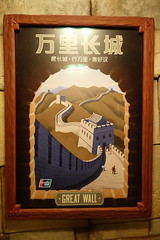 if you’ve been on the other Soaring Around the World updates in California or Florida, then you’ve already experienced the exact same attraction, save for the final scene in which here you fly through the Shanghai skyline.2 You get sweeping panoramic views of top worldwide destinations such as the Great Pyramids, Mt. Killamanjaro, the Great Wall (of course), fake Taj Mahal, somewhere in the Pacific islands, somewhere a global warming commercial was probably being filmed, and the Eiffel Tower as the penultimate finale where the music swells and we’re supposed to be in awe at this pinnacle of eurocentric civilization, except the filmmakers forgot that vertical lines can’t project straight on a half-dome screen unless your seat is dead center, and my amazement
if you’ve been on the other Soaring Around the World updates in California or Florida, then you’ve already experienced the exact same attraction, save for the final scene in which here you fly through the Shanghai skyline.2 You get sweeping panoramic views of top worldwide destinations such as the Great Pyramids, Mt. Killamanjaro, the Great Wall (of course), fake Taj Mahal, somewhere in the Pacific islands, somewhere a global warming commercial was probably being filmed, and the Eiffel Tower as the penultimate finale where the music swells and we’re supposed to be in awe at this pinnacle of eurocentric civilization, except the filmmakers forgot that vertical lines can’t project straight on a half-dome screen unless your seat is dead center, and my amazement of this scene sitting
of this scene sitting on the righthand seat bank was purely along the lines of “woah, how did they get the licensing rights to Inception?” The Leaning Tower of Paris is more like it.
on the righthand seat bank was purely along the lines of “woah, how did they get the licensing rights to Inception?” The Leaning Tower of Paris is more like it.
I would say the new film makes the most sense in Epcot where at least the global theme and presentational style is already a part of that park’s DNA; it makes only slightly more sense here than it does in California, but it both cases the new worldwide thesis is an odd fit, seemingly done only to one-up the original ride like a bad Hollywood sequel. (“What’s bigger and better than an entire state? How about the WHOLE WORLD!”) I’m sure the argument has been made before that the new globally-themed film was commissioned with a Chinese audience in mind, under the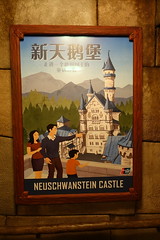 assumption that the Chinese
assumption that the Chinese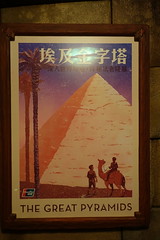 are more insulated from the rest of the world, and will excuse the film’s rather unfocused approach on this justification. But really, that’s utter crap; Americans aren’t going to have seen the vast majority of these landmarks either, and the Chinese audiences who are affluent enough to go to Shanghai Disneyland are probably just as likely to have traveled outside their home country as the average American Magic Kingdom visitor.3
are more insulated from the rest of the world, and will excuse the film’s rather unfocused approach on this justification. But really, that’s utter crap; Americans aren’t going to have seen the vast majority of these landmarks either, and the Chinese audiences who are affluent enough to go to Shanghai Disneyland are probably just as likely to have traveled outside their home country as the average American Magic Kingdom visitor.3
More than the CG animals and jarring scene transitions,4 the real issue with Soaring Over the Horizon is that it has no thesis. These images are universally known to both Chinese and American audiences, and there’s no common theme linking them other than that they all take place on Earth, a topic so vast that Disney’s attempt to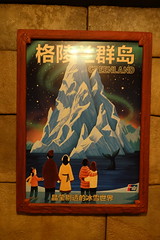 summarize
summarize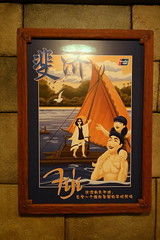 it in five minutes comes off as almost laughably naive. What value is there in watching this parade of global clichés, other than to witness them all in a more immersive aspect ratio than we can get when they pop up on our phone’s Facebook feed from a distant friend’s vacation photos? Soaring wants to tap into the feelings of euphoric wonder and discovery that drive the success of documentaries like BBC’s Planet Earth, but it fails to recognize two key elements necessary for that emotional response: One, that we believe the images we’re seeing are authentic, and two, that we’re seeing something we haven’t seen before and that transcends our expectations. While Soarin’ Over California wasn’t perfect, it was substantially better at satisfying both of these qualities, and is still the superior film.
it in five minutes comes off as almost laughably naive. What value is there in watching this parade of global clichés, other than to witness them all in a more immersive aspect ratio than we can get when they pop up on our phone’s Facebook feed from a distant friend’s vacation photos? Soaring wants to tap into the feelings of euphoric wonder and discovery that drive the success of documentaries like BBC’s Planet Earth, but it fails to recognize two key elements necessary for that emotional response: One, that we believe the images we’re seeing are authentic, and two, that we’re seeing something we haven’t seen before and that transcends our expectations. While Soarin’ Over California wasn’t perfect, it was substantially better at satisfying both of these qualities, and is still the superior film.
If there is one aspect to Soaring Over the Horizon that’s classic Disney, it’s the corporate sponsorship.
Soaring may have been a bit of a disappointment, but it’s still a Soarin’ experience and its hidden location sitting on the periphery of Adventure Isle at least makes it pretty harmless, and still better to have than nothing.
At the heart of Adventure Isle is Roaring Mountain, my pick for the most spectacular landmark in the park.
And at the base of Roaring Mountain is Camp Discovery, one of two individual attractions in the park to win a Thea Award; also, the two that most rightly deserve special recognition.
Camp Discovery is a collection of several activities, primary among them are the three separate Challenge Trails. This area is deceptively large, and depending on the waits for the Challenge Trails, one could easily spend half a day in here just to see and do everything.
Of course we were mainly here for the Camp Discovery Challenge Trails.
Here’s a list of rules for the Challenge Trails. Sadly, the top rule is that all loose items, including cameras and cellphones, must be secured in a locker before you’ll even be allowed to enter the queue, so my photos of the experience are fairly limited.
 The Challenge Trails give you the choice between three separate routes: Waterfall, Caverns, and Temple, likely in that order of quality. I only got to do Waterfall, but would have loved to have done all three, and this is the one thing I most wish I had planned more time for. It’s easy to look at it and think “B-ticket, maybe C-ticket at best”, but these Challenge Trails punch way above their class. Unlike most climbing structures at major theme parks which are designed to be open, unrestricted play, the Camp Discovery Challenge Trails are skewed to a much older demographic and require helmets, harnesses, and a bit of actual skill to navigate, all of which you will most definitely need to survive these courses.
The Challenge Trails give you the choice between three separate routes: Waterfall, Caverns, and Temple, likely in that order of quality. I only got to do Waterfall, but would have loved to have done all three, and this is the one thing I most wish I had planned more time for. It’s easy to look at it and think “B-ticket, maybe C-ticket at best”, but these Challenge Trails punch way above their class. Unlike most climbing structures at major theme parks which are designed to be open, unrestricted play, the Camp Discovery Challenge Trails are skewed to a much older demographic and require helmets, harnesses, and a bit of actual skill to navigate, all of which you will most definitely need to survive these courses. The Waterfall route features an absolutely incredible section, blocked from view to the public, where we encounter the eponymous waterfall5 falling through the middle of a seemingly bottomless rock chasm, and our only way past it is to clamber along the thinnest of rock ledges around either side of the chasm with nothing to hold on to (save one’s own butt). Completing the challenge proved exhilarating in a way few thrill rides can compare to, and it was absolutely unlike anything I had ever encountered at a Disney park ever before. The capacity can sometimes be as much of a challenge as the courses themselves, but I cannot emphasize enough that the Camp Discovery Challenge Trails are Not. To. Be. Missed.
The Waterfall route features an absolutely incredible section, blocked from view to the public, where we encounter the eponymous waterfall5 falling through the middle of a seemingly bottomless rock chasm, and our only way past it is to clamber along the thinnest of rock ledges around either side of the chasm with nothing to hold on to (save one’s own butt). Completing the challenge proved exhilarating in a way few thrill rides can compare to, and it was absolutely unlike anything I had ever encountered at a Disney park ever before. The capacity can sometimes be as much of a challenge as the courses themselves, but I cannot emphasize enough that the Camp Discovery Challenge Trails are Not. To. Be. Missed.
Elsewhere, this cute little statue is one of many details to discover throughout Camp Discovery.
More sculptural details. The internet tells me there’s an original backstory to this land involving a tribe known as the Arbori, but honestly I couldn’t find evidence of that backstory anywhere in print within the land itself. Given how often a half-baked story can detract from otherwise good design, perhaps that’s just as well.
Down here is the House of the Ancients.
The lower level is a sand pit with artifacts you can excavate.
The upper level includes a section of the Temple Challenge Trail route. Notice how narrow the ledges are? And this is supposed to be the easiest of the three trails that (evidently) no one wants to bother with.
There also seemed to be something involving these cameras and the angles of the windows, but I couldn’t figure out what it is. Makes me wonder if this area has some hidden perspective puzzles à la The Witness.
I’ll return to check out more of Camp Discovery later this evening, there’s more to uncover around the rest of Adventure Isle first.
Such as more about the food and drink offerings, which we sampled at Adventure Isle’s main eatery named the… really, guys? Tribal Table.
The inside is nicely decorated with lots of fine examples of the artistic genre known as “white people making indigenous-looking things”
Our meals, the Gong Bao Chicken and Arbori Roasted Chicken. A mild improvement over Barbossa’s Bounty.
I’m sure to an American palate Shanghai’s offerings would rank the among the worst of all Disney park food, although I’m not sure Chinese tastes would rank it as poorly. However, at roughly $10 per entree, Chinese do consider it outrageously expensive, a price that Americans are used to in their theme parks. They offered a deal where two adult combos came with a free kid’s meal, I’m sure in response to these complaints and the local family composition. We didn’t need it but weren’t going to refuse it, so we got the prawns with rice, something I doubt you’d see on any kid’s menu in the States.
Alright, now the star of Adventure Isle… Roaring Rapids.
The star of Roaring Rapids is foreshadowed by this stone idol out front: Q’aráq, the reason these rapids roar.
I had a hell of a time getting to do Roaring Rapids, and I almost feared I wouldn’t get to ride it at all. FastPass ran out very quickly, and the ride was down and completely drained more than half the times I walked by it on both days. Finally, as the afternoon was turning to evening on day two, we found it open and, posted-120-minute-wait-be-damned, entered the standby queue.
A small stone Q’aráq greets us as we enter this standby queue of doom.
One lesson for Shanghai Disneyland: prioritize Roaring Rapids and Soaring Over the Horizon FastPasses over all else, unless you want to be stuck here for two hours. (It ended up closer to 90 minutes… who’s really counting?)
The queue offers some themed details to look at.
No, it’s not an Indiana Jones Adventure-level immersive queue, basically just a series of covered switchbacks with a couple random pens along the way for an Imagineering scenic designer to dump a ton of stuff, but at least it kind of establishes the time and place of the story, and there’s a lot to play I-Spy with.
Signs warn us to put our ponchos on before boarding the raft. We declined the ¥5 ponchos (approximately $1) on sale when we entered the queue, but in a genius bit of salesmanship, Disney positioned another poncho seller moments before stepping onto the boarding platform, at which point our trepidations caused us to reconsider. Here’s Yiyan in her poncho.
About to board. Thank Q’aráq there were no breakdowns while we were in line. Time to put my camera away!
 Roaring Rapids is easily my new favorite round raft rapids ride, although I tend to avoid these types of attraction for the simple reason I generally dislike getting wet in street clothes. Paradoxically, when I do ride these attractions, I find that I really get into them, perhaps because they’re still somewhat of a novelty to me, and perhaps because the threat of an errant wave soaking me to the bone is enough to destroy whatever critical distance I might have in the moment and keep me fully engaged and immersed as the experience unfolds. Go figure.
Roaring Rapids is easily my new favorite round raft rapids ride, although I tend to avoid these types of attraction for the simple reason I generally dislike getting wet in street clothes. Paradoxically, when I do ride these attractions, I find that I really get into them, perhaps because they’re still somewhat of a novelty to me, and perhaps because the threat of an errant wave soaking me to the bone is enough to destroy whatever critical distance I might have in the moment and keep me fully engaged and immersed as the experience unfolds. Go figure.
As far as I can tell, Roaring Rapids has an identical layout to Grizzly River Run at California Adventure,6 which before now was also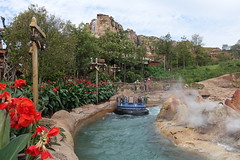 my favorite round raft rapids ride. Roaring Rapids one-ups it with an overall superb environmental design. You really get the sense of heading out on some distant expedition in a way that’s far more “Disney’s Animal Kingdom” than it is “Jungle Cruise”, and the mountaintop setting coupled with the fleetingly glimpsed cryptozoological creature makes Roaring Rapid’s next closest kindred spirit Expedition Everest, of all rides (and not the short and hectoring Kali River Rapids).
my favorite round raft rapids ride. Roaring Rapids one-ups it with an overall superb environmental design. You really get the sense of heading out on some distant expedition in a way that’s far more “Disney’s Animal Kingdom” than it is “Jungle Cruise”, and the mountaintop setting coupled with the fleetingly glimpsed cryptozoological creature makes Roaring Rapid’s next closest kindred spirit Expedition Everest, of all rides (and not the short and hectoring Kali River Rapids).
The encounter with the giant reptilian Q’aráq near the middle of the ride layout was surprisingly effective; I had my doubts it could work due to the unpredictable spinning of the raft, but from my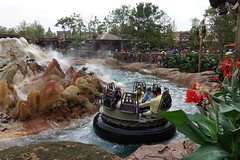 view at least the monster was positioned as best as it could have been to make sure that we all saw its gaping maw as it lunged after our raft. You could argue that it’s a bit of a waste for such an elaborate animatronic figure to be visible for only a few seconds, especially as it’s the only one to be found in Adventure Isle and sort of the central figure of the land’s entire mythology; but I actually really appreciate how its rarity lends it a fleeting ephemerality that makes my brief memories of it more valuable to me, much like how I imagine I would remember an actual brief encounter with a mythical creature I could barely believe exists before I blink my eyes and it’s gone.
view at least the monster was positioned as best as it could have been to make sure that we all saw its gaping maw as it lunged after our raft. You could argue that it’s a bit of a waste for such an elaborate animatronic figure to be visible for only a few seconds, especially as it’s the only one to be found in Adventure Isle and sort of the central figure of the land’s entire mythology; but I actually really appreciate how its rarity lends it a fleeting ephemerality that makes my brief memories of it more valuable to me, much like how I imagine I would remember an actual brief encounter with a mythical creature I could barely believe exists before I blink my eyes and it’s gone.
There’s much less “story” than on a typical Disney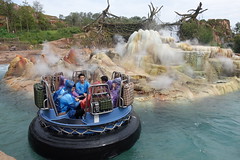 attraction (certainly less than Kali River), yet just enough exposition lurking in the background that you can fashion together your own experiential story however you’d like (better than Grizzly River), and the result is kind of perfect for what it wants to be. And ultimately we didn’t get too wet on Roaring Rapids, and I suspect that too may have factored into my largely favorable impression of it. If it had held us under a big dumb waterfall for five seconds like seemingly every Cedar Fair rapids ride I’ve come across, my opinion would be very different. (Although, a word of advice, the person sitting next to the loading/unloading gap on the raft is much more likely to get their pants drenched than a middle seat.)
attraction (certainly less than Kali River), yet just enough exposition lurking in the background that you can fashion together your own experiential story however you’d like (better than Grizzly River), and the result is kind of perfect for what it wants to be. And ultimately we didn’t get too wet on Roaring Rapids, and I suspect that too may have factored into my largely favorable impression of it. If it had held us under a big dumb waterfall for five seconds like seemingly every Cedar Fair rapids ride I’ve come across, my opinion would be very different. (Although, a word of advice, the person sitting next to the loading/unloading gap on the raft is much more likely to get their pants drenched than a middle seat.)
The ride concludes with this waterfall around a whirlpool and down beneath this vine bridge.
It then gently drifts past this beautiful bend around thermal springs, back to the station.
Would I rate Roaring Rapids among my top three attractions in Shanghai Disneyland? Quite possibly. Even if you don’t like water rides, get a poncho for less than a buck and try it once. I’m very glad I didn’t miss out.
Roaring Mountain beckons me back to it in the evening sun.
As cool as Camp Discovery is during the day, it’s especially magical at twilight.
The Vista Trail is a walking path that winds its way up and through the mountain, taking you behind the main waterfall and past many of the obstacles on the Cavern Challenge Trail. It’s great to simply explore this space, especially at night with no crowds; I only wish that Shanghai Disneyland could have more areas like this.
At night, Roaring Mountain glows radiantly.
Like Tomorrowland, Adventure Isle is well worth your while to stick around and explore after nightfall.

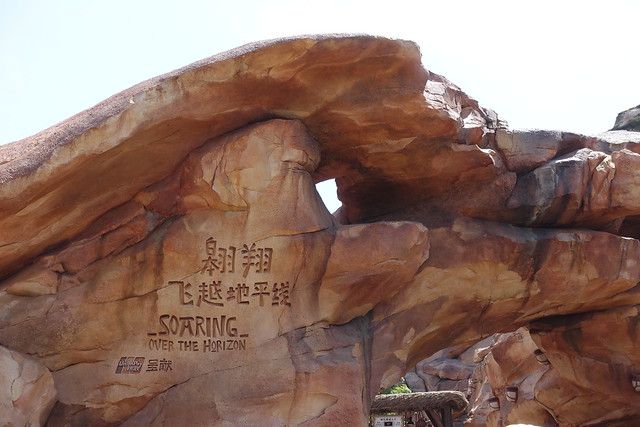
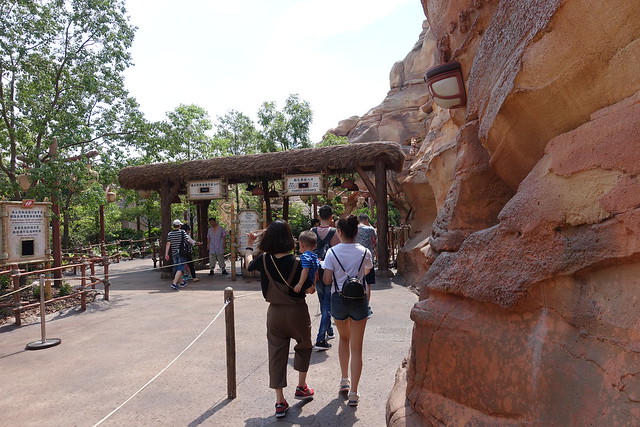

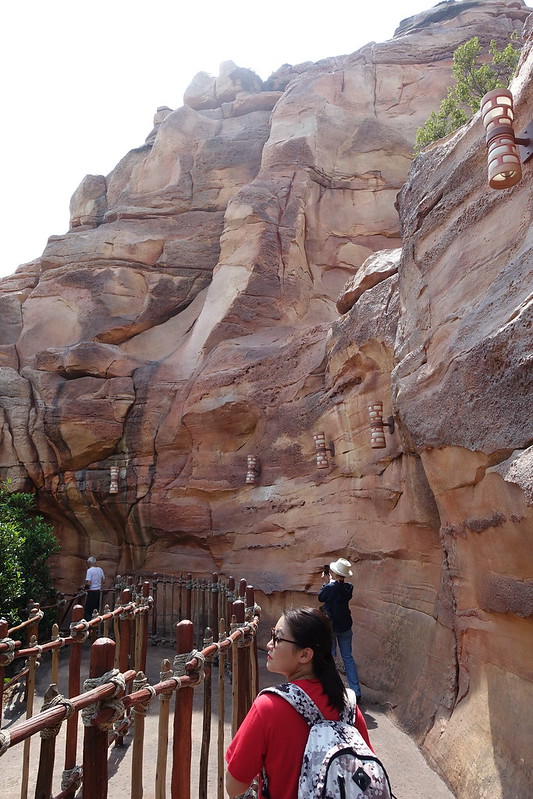
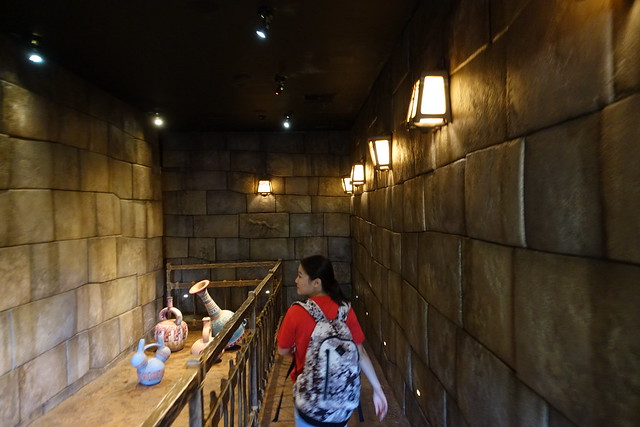





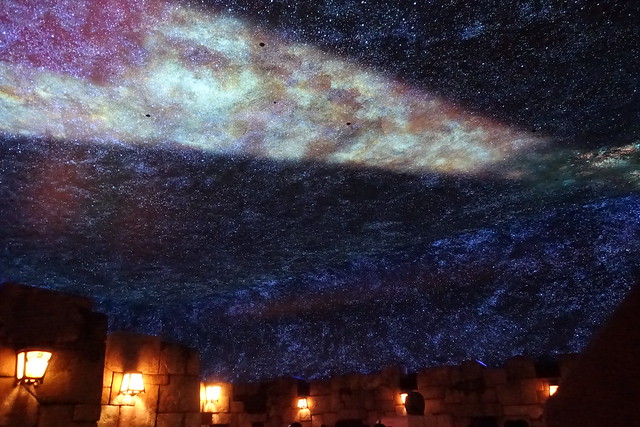
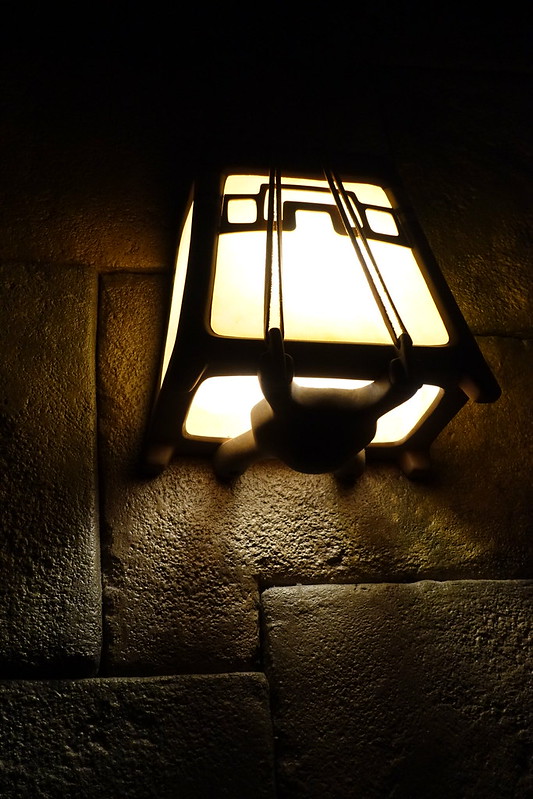

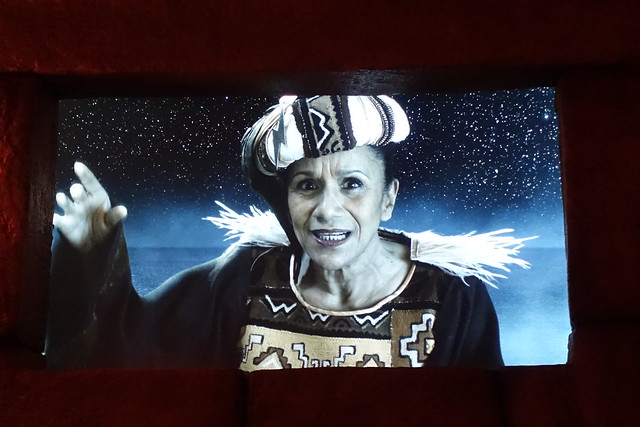
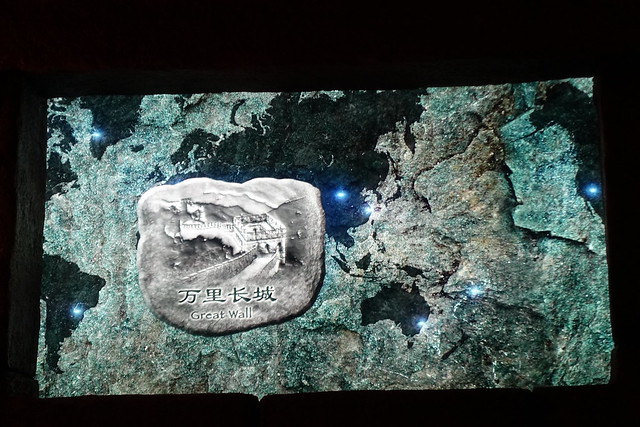
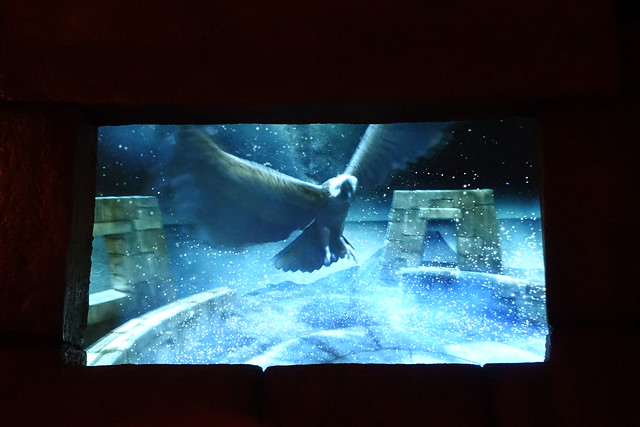


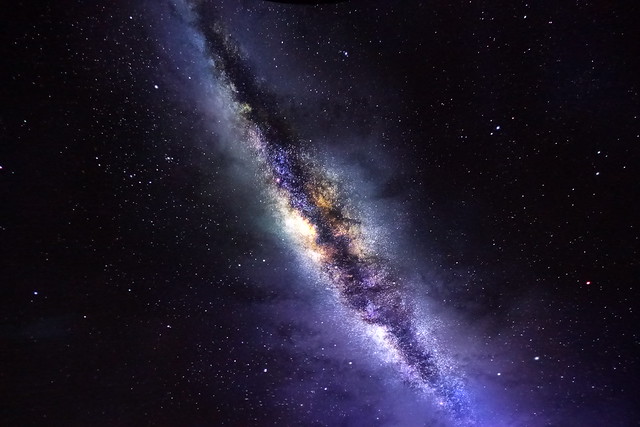
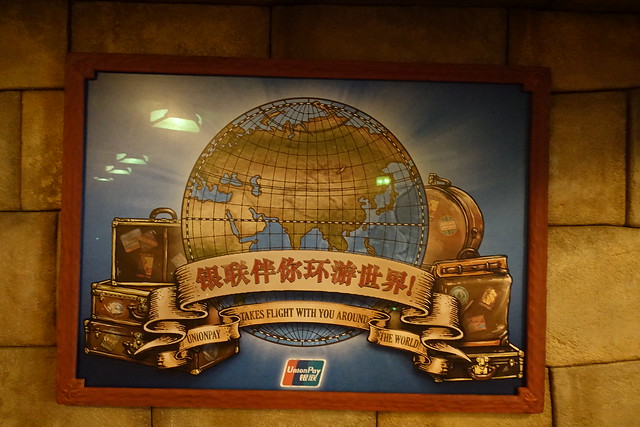
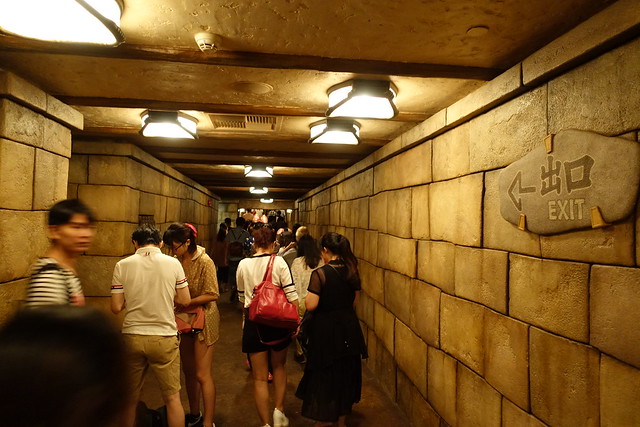
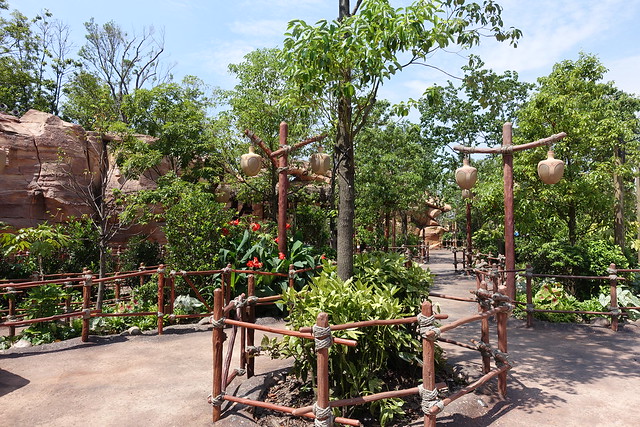
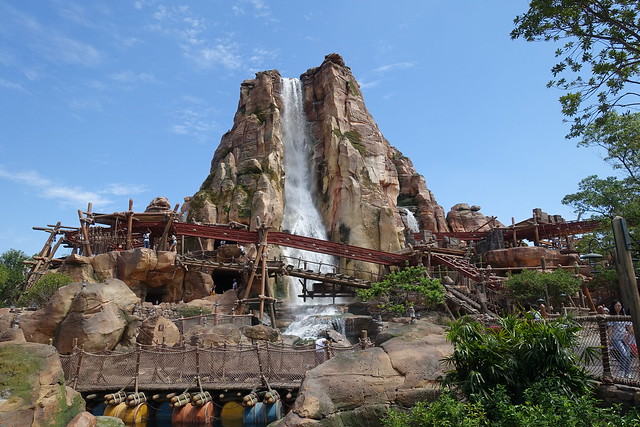


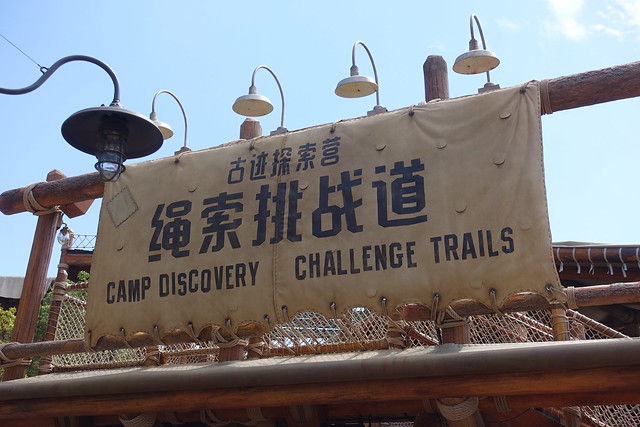

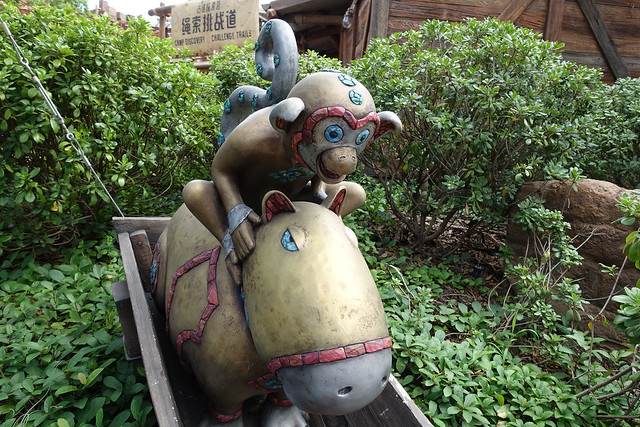

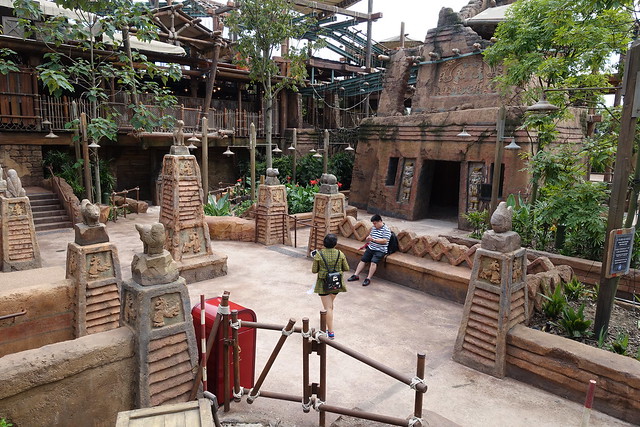


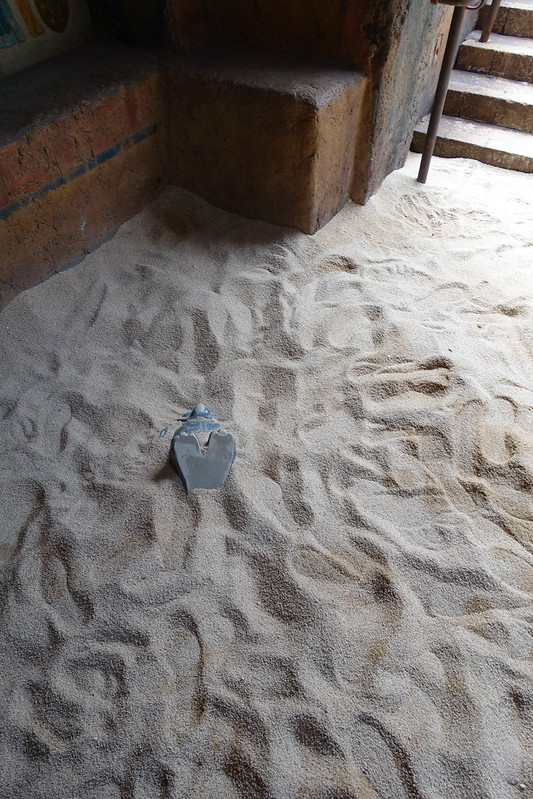

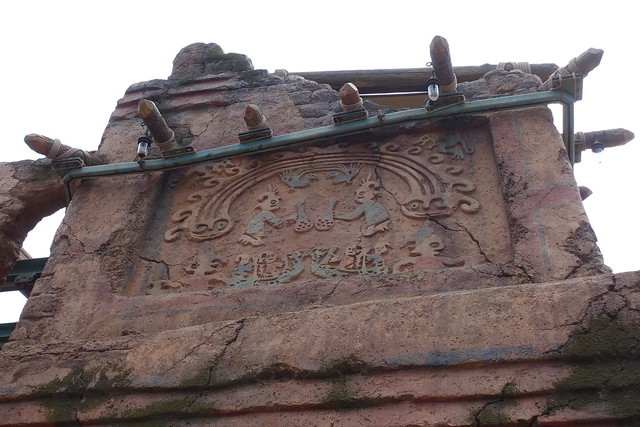
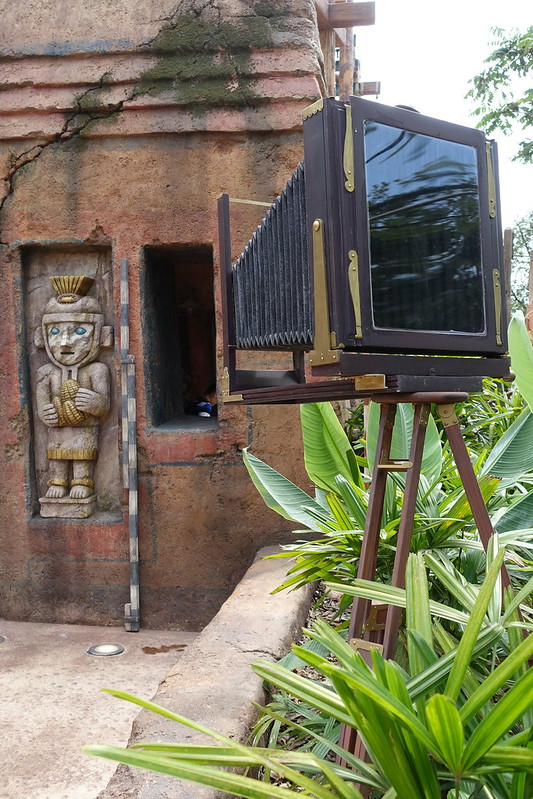

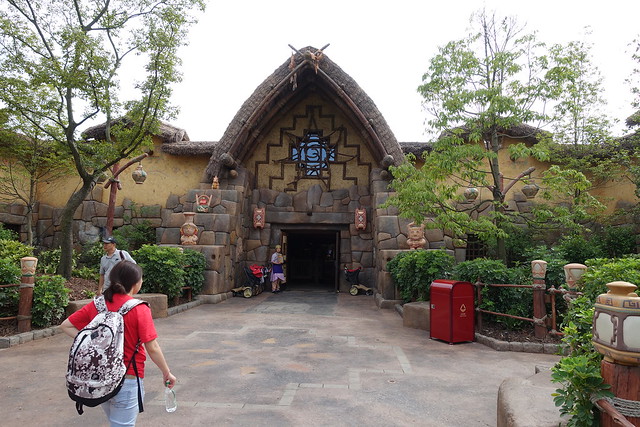
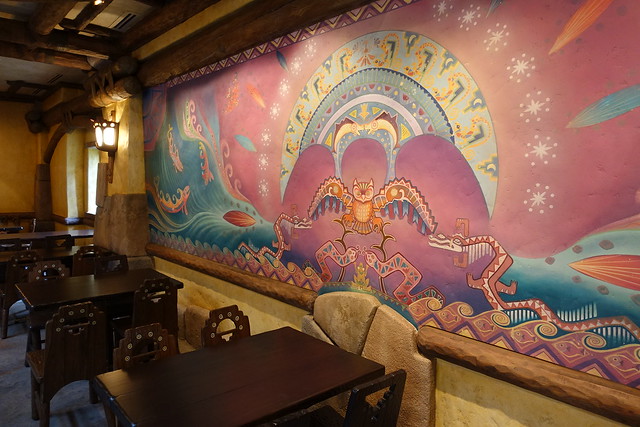
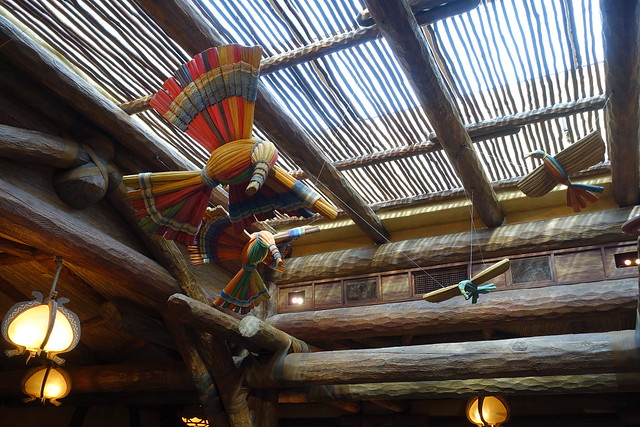



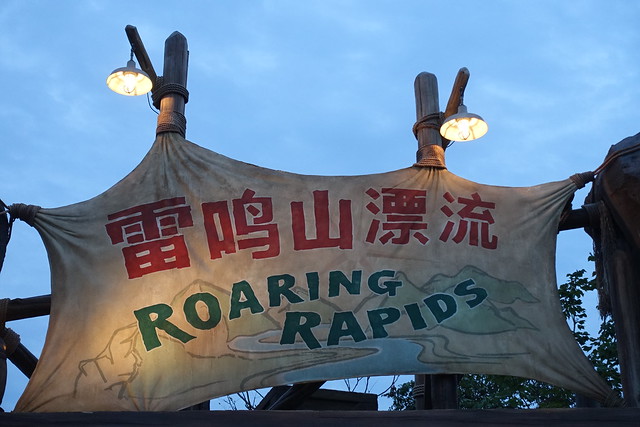
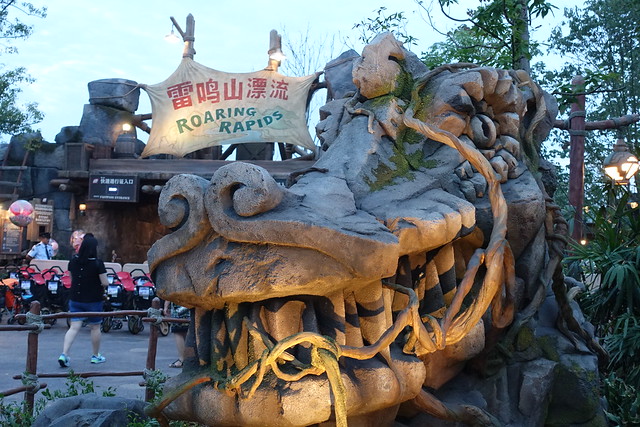
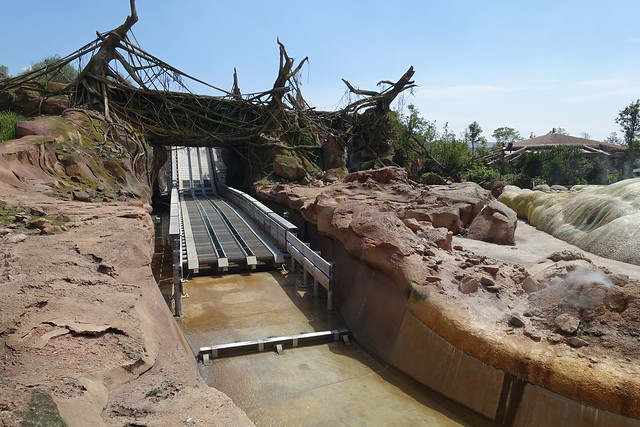



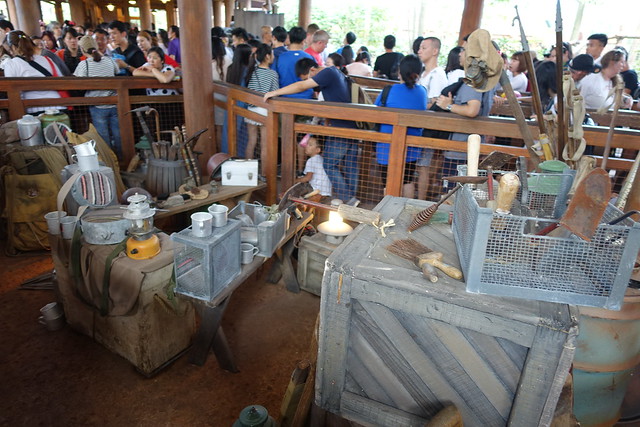
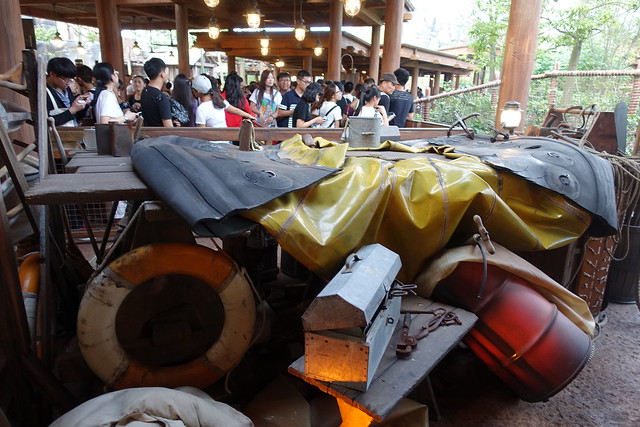
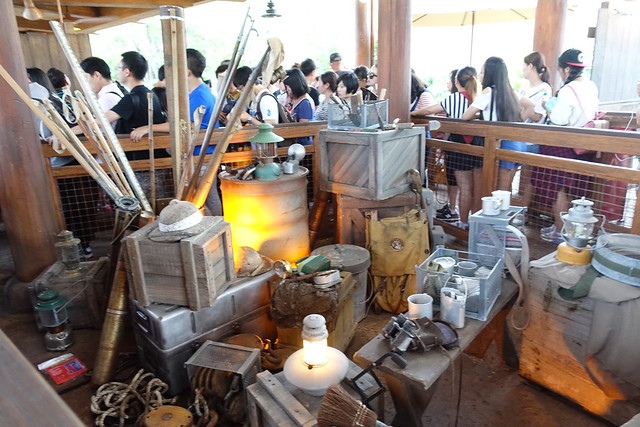
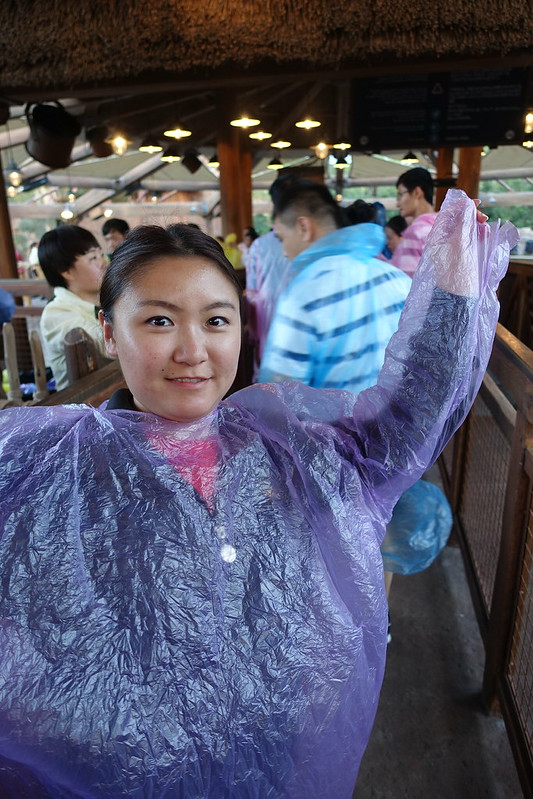

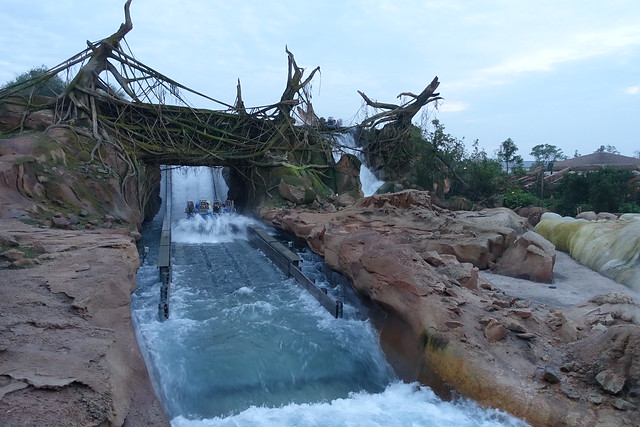
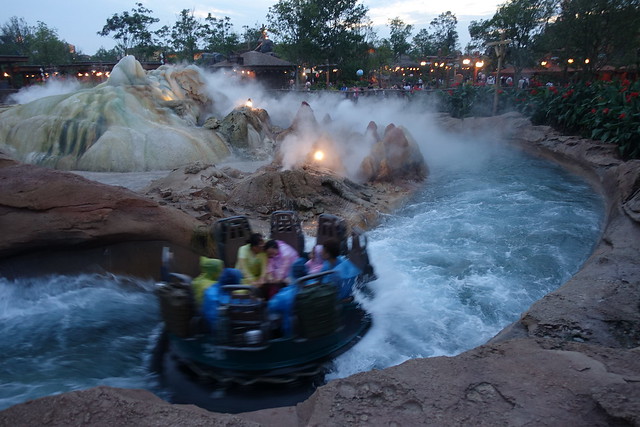
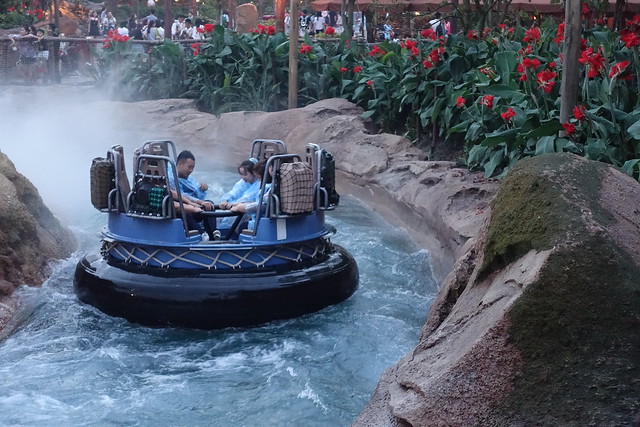

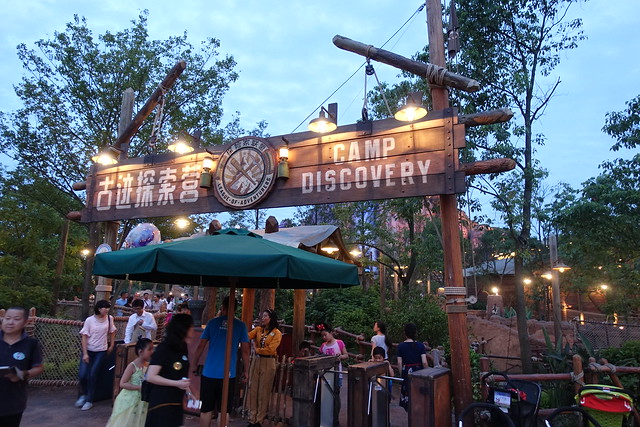
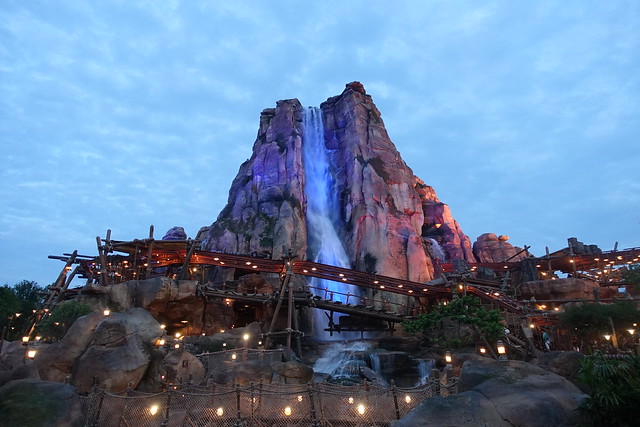
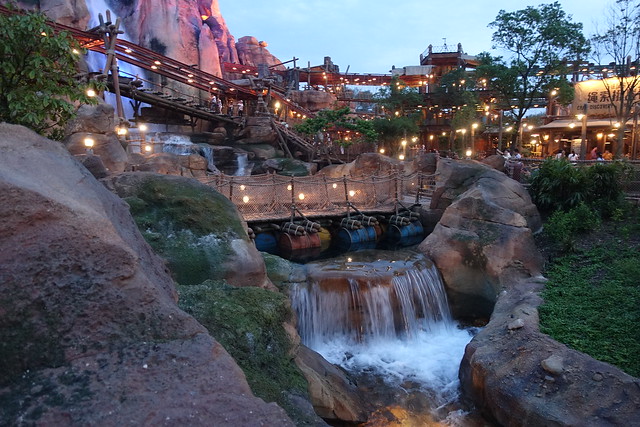



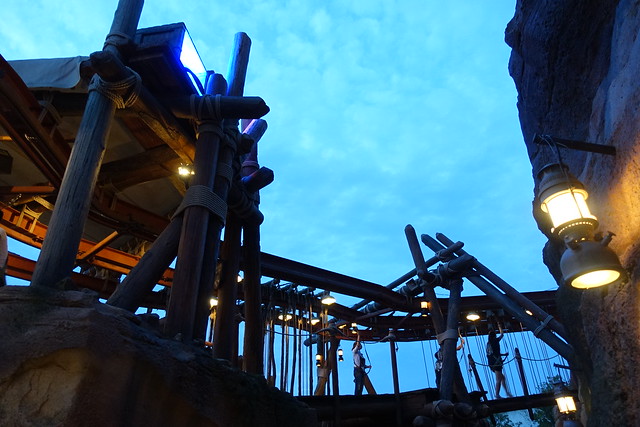

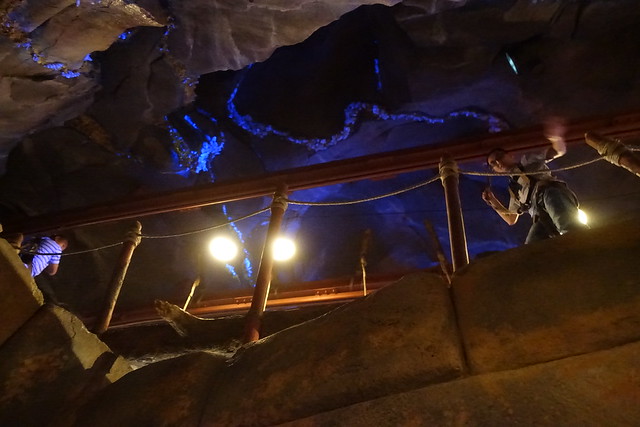
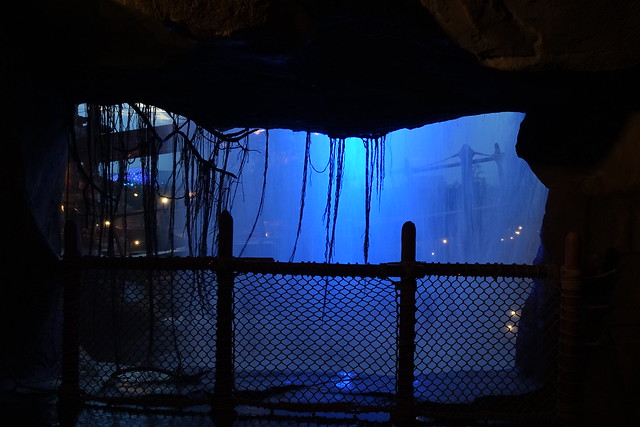
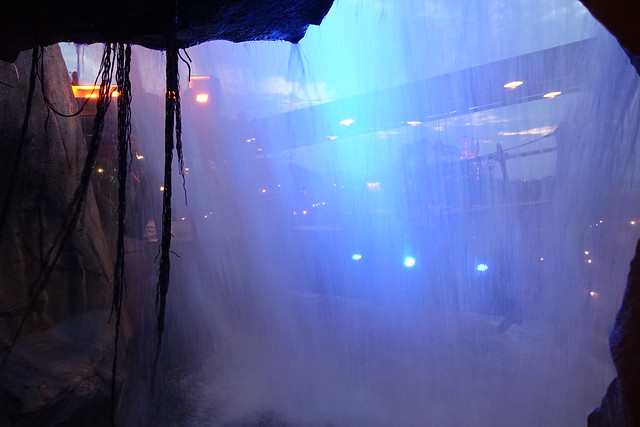

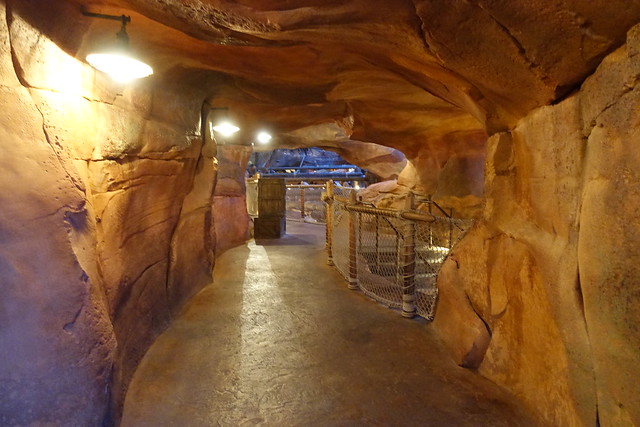
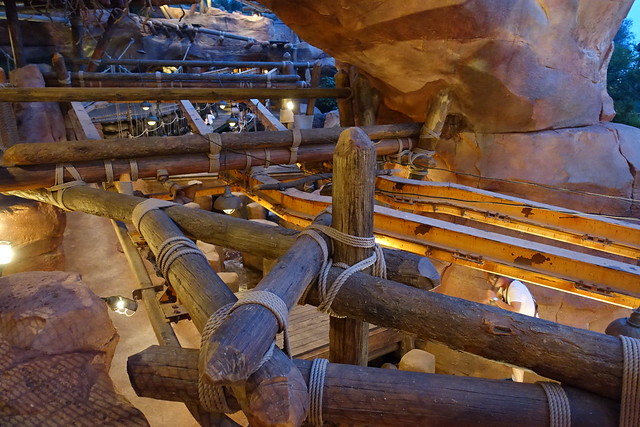
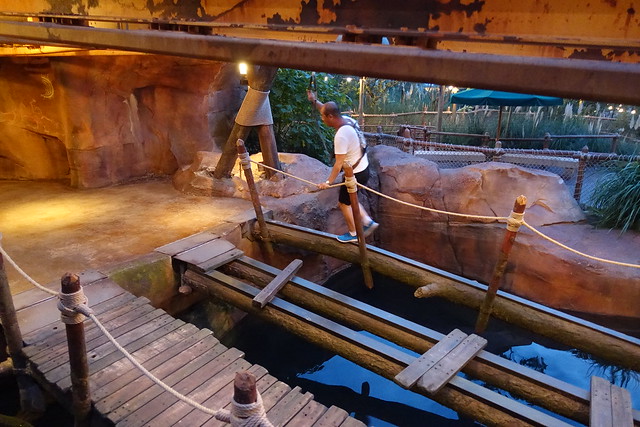

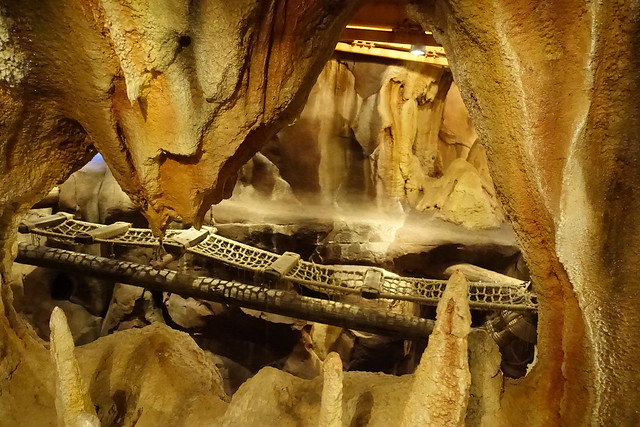
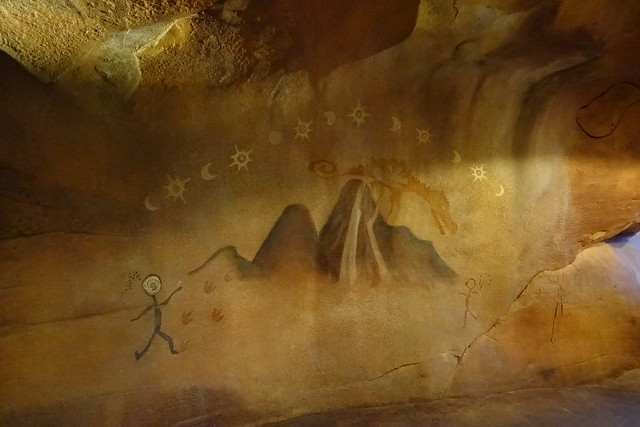
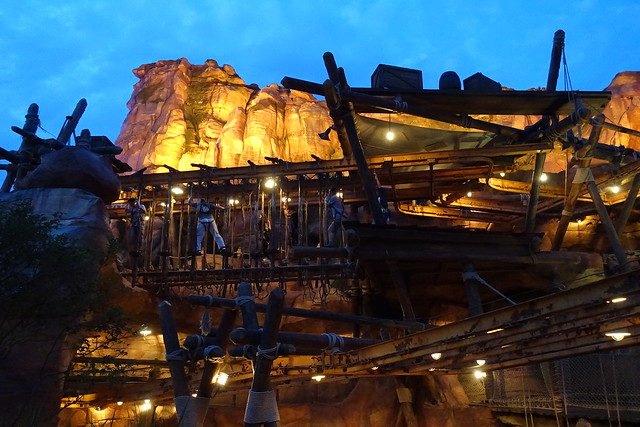

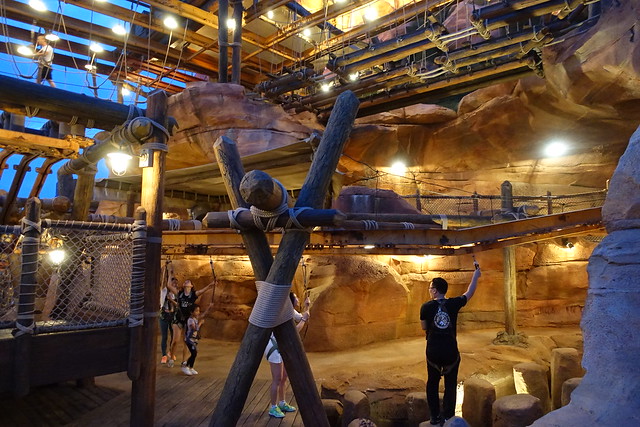
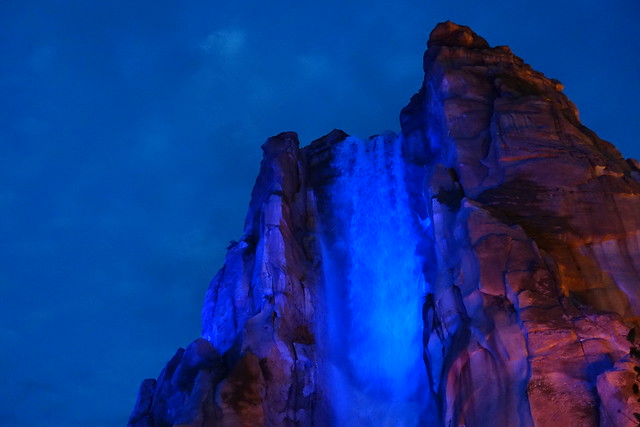
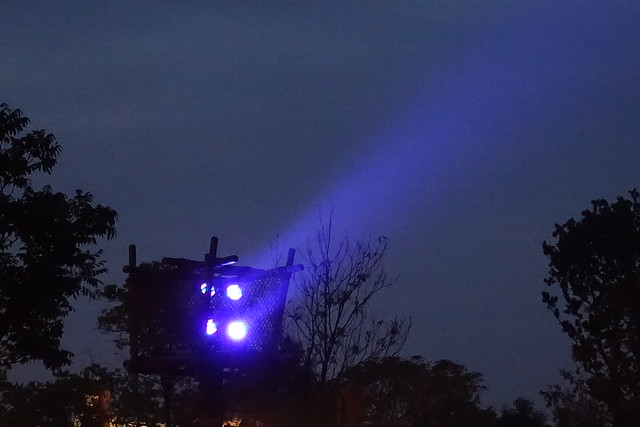


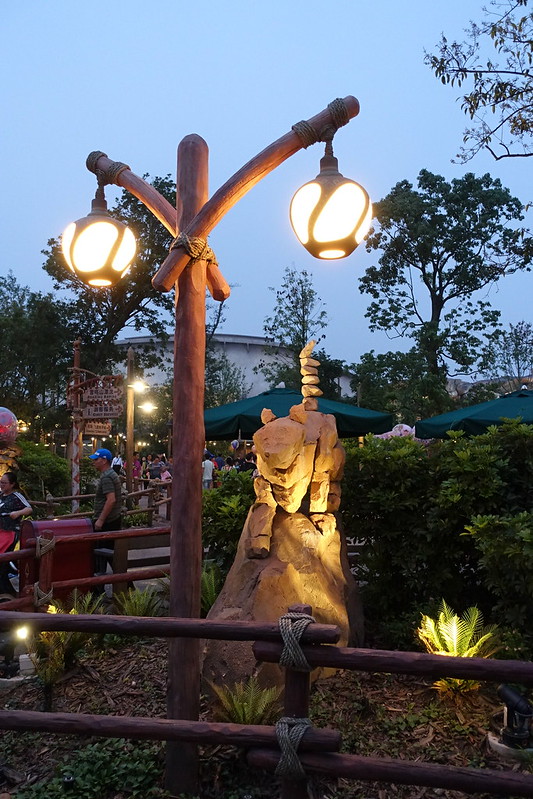
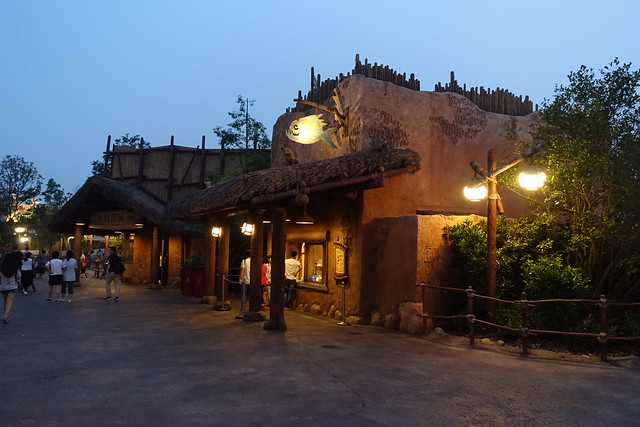
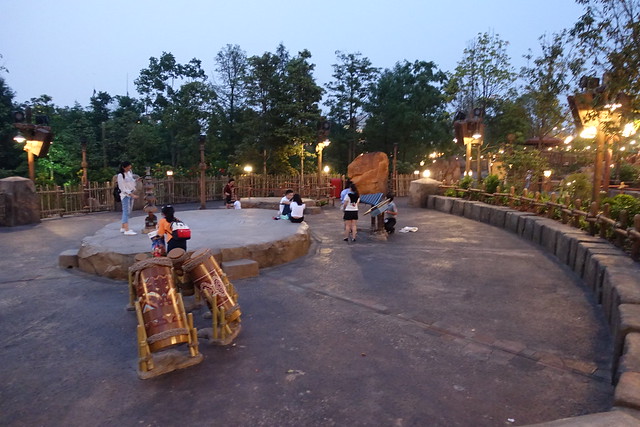
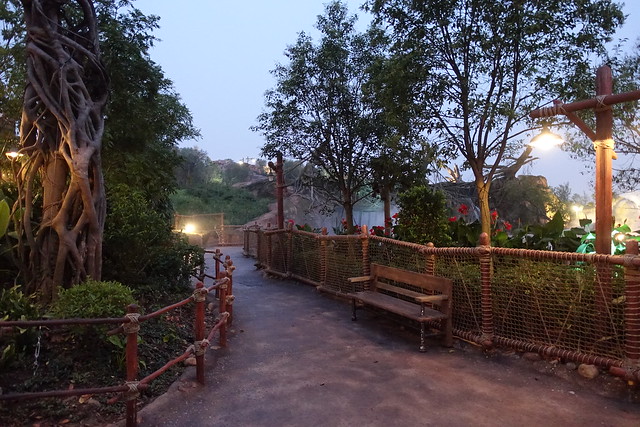

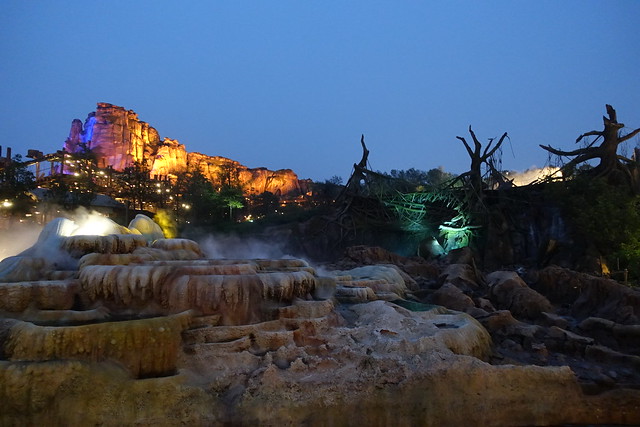
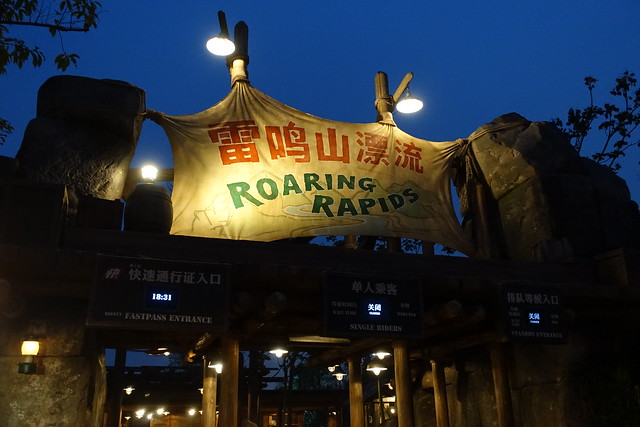
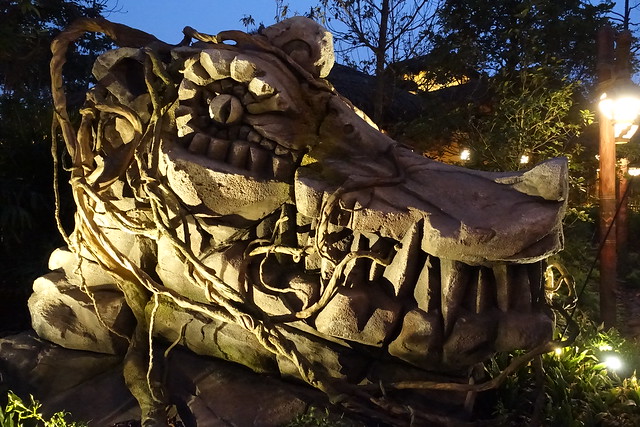
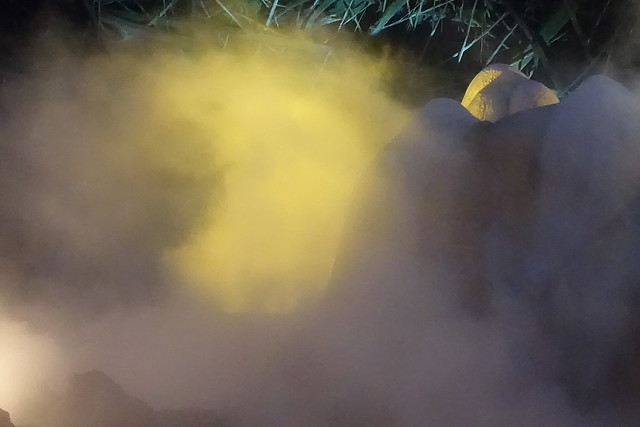




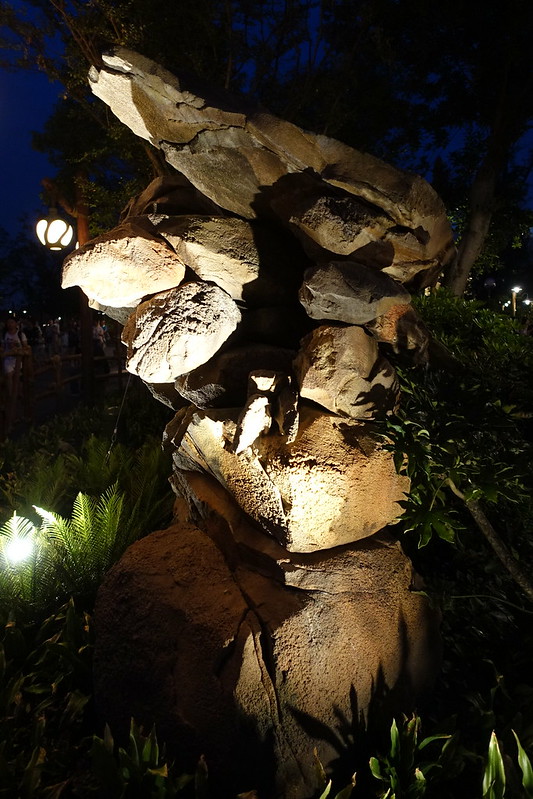
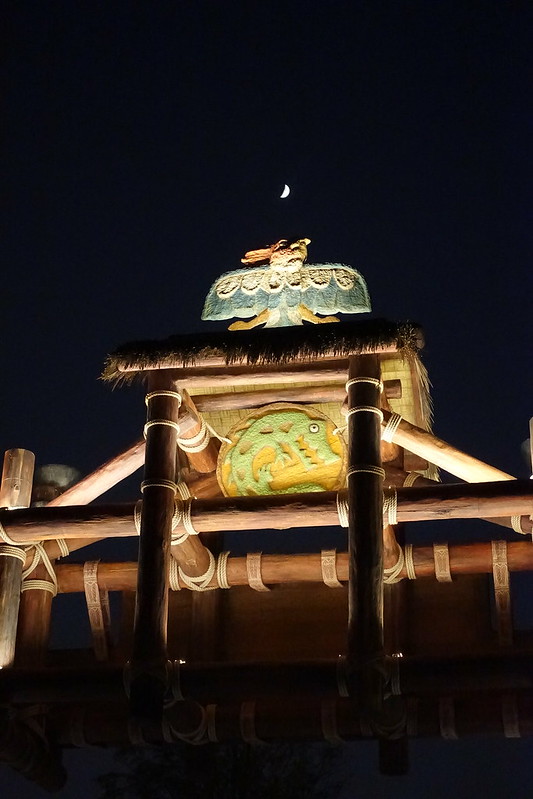
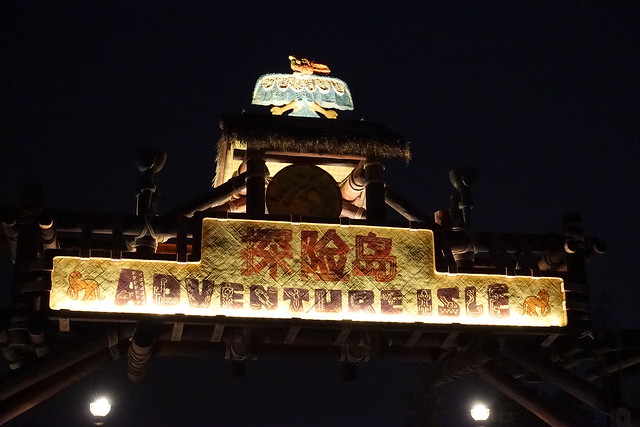
Comments